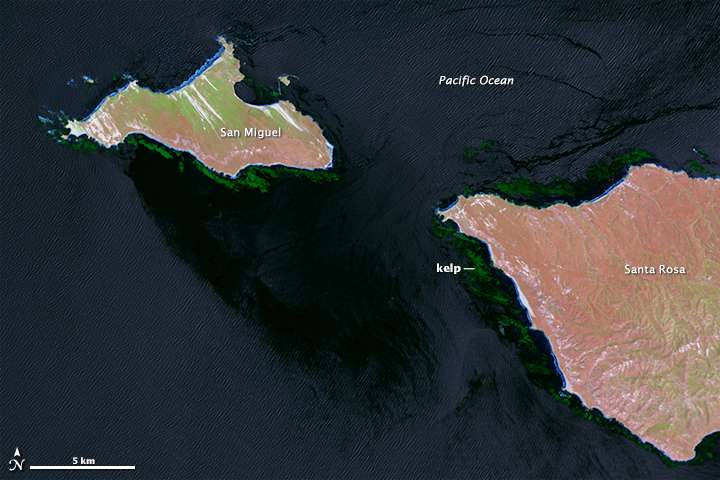Image: Channel Islands kelp beds 2013
Description: The natural color (top) and near-infrared (bottom) images at the top of this page show the kelp-rich waters around California’s Channel Islands, as observed on May 20, 2013, by the Operational Land Imager on Landsat 8. Wave patterns are visible on the water surface in both images, as is the water and wind shadow on the southeast side of San Miguel, where the ocean surface is smoother. The kelp are very difficult to spot in natural color, but a combination of near-infrared and natural color (bands 6-5-4) helps them stand out (second image). Turn on the image comparison tool to highlight the kelp. Landsat measures the energy reflected and emitted from Earth at many different wavelengths. Knowing how features on Earth reflect or absorb energy at certain wavelengths helps scientists map and measure changes to the surface. The most important feature for the kelp researchers is Landsat’s near-infrared band, which measures wavelengths of light that are just outside of our visual range. Healthy vegetation strongly reflects near-infrared energy, so this band is often used in plant studies. Also, water absorbs a lot of near-infrared energy and reflects little, making the band particularly good for mapping boundaries between land and water. “The near-infrared is key for identifying kelp from surrounding water,” said Kyle Cavanaugh, a marine biologist who uses remote sensing. “Like other types of photosynthesizing vegetation, giant kelp have high reflectance in the near infrared. This makes the kelp canopy really stand out from the surrounding water.”
Title: Channel Islands kelp beds 2013
Credit: http://earthobservatory.nasa.gov/IOTD/view.php?id=85023&src=eoa-iotd
Author: NASA Earth Observatory image by Mike Taylor and Jesse Allen
Permission: Public domainPublic domainfalsefalse This file is in the public domain in the United States because it was solely created by NASA. NASA copyright policy states that "NASA material is not protected by copyright unless noted". (See Template:PD-USGov, NASA copyright policy page or JPL Image Use Policy.) Warnings: Use of NASA logos, insignia and emblems is restricted per U.S. law 14 CFR 1221. The NASA website hosts a large number of images from the Soviet/Russian space agency, and other non-American space agencies. These are not necessarily in the public domain. Materials based on Hubble Space Telescope data may be copyrighted if they are not explicitly produced by the STScI.[1] See also Template:PD-Hubble and Template:Cc-Hubble. The SOHO (ESA & NASA) joint project implies that all materials created by its probe are copyrighted and require permission for commercial non-educational use. [2] Images featured on the Astronomy Picture of the Day (APOD) web site may be copyrighted. [3] The National Space Science Data Center (NSSDC) site has been known to host copyrighted content. Its photo gallery FAQ states that all of the images in the photo gallery are in the public domain "Unless otherwise noted."
Usage Terms: Public domain
License: Public domain
Attribution Required?: No
Image usage
The following page links to this image:


